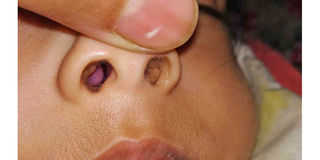Prime
How enlarged adenoids is affecting children’s growth, learning

What you need to know:
- Health experts warn that these symptoms could indicate a silent but disruptive condition known as enlarged adenoids, which, if left untreated, can interfere with a child’s breathing, growth, hearing, sleep and learning
Dar es Salaam. In many Tanzanian households, a child who snores, suffers frequent colds, or sleeps with their mouth open may not raise immediate concern.
However, health experts warn that these symptoms could indicate a silent but disruptive condition known as enlarged adenoids, or nyama za puani which, if left untreated, can interfere with a child’s breathing, growth, hearing, sleep and learning.
An Ear Nose and Throat (ENT) specialist at CCBRT Hospital in Dar es Salaam, Dr Khuzema Rangwala, says he has seen a growing number of cases related to adenoid hypertrophy.
“This is one of the most underestimated conditions in children. While it may appear minor, it can have a severe impact on brain development and overall growth,” he said.
Adenoids are lymphatic tissues located where the nose meets the throat.
They play a role in a child’s immune system, especially in early years.
However, due to their location and children’s small nasal structures, they can enlarge and block airways, triggering a series of health challenges.
“The most common signs are snoring at night, persistent flu and mouth breathing,” Dr Rangwala noted.
“A child who cannot breathe properly during sleep receives less oxygen, which affects brain function.”
He added that poor oxygenation at night disrupts sleep quality, leading to daytime fatigue, poor concentration and declining academic performance.
“You send this child to school, but instead of learning, he is dozing off because he didn’t sleep well at night,” he said.
Alongside poor learning outcomes, other signs of adenoid problems include frequent colds, nasal voice, ear infections, hearing issues, and a constant runny nose.
Chronic mouth breathing may even change facial development, resulting in an open mouth posture, a receding chin and prominent upper teeth in what doctors call “adenoid facies.”
An ENT specialist at Aga Khan Hospital, Dar es Salaam, Dr Christopher Mwansasu, says the number of cases has increased in recent years.
“We see more children with symptoms like frequent snoring, open-mouth breathing, and interrupted sleep,” he said.
“Other signs include hearing loss, refusal to eat or breastfeed, weight loss, and poorly aligned teeth.”
According to him, children between one and six years old are most affected, with three-year-olds being particularly vulnerable.
Although there is no national database tracking adenoid-related cases, specialists across public and private hospitals report a sharp rise in paediatric ENT consultations.
Part of this increase may be attributed to growing urbanisation.
As families move into cities, children are exposed to allergens such as dust, air pollution, perfumes, and cleaning products, which inflame adenoids.
“Allergy-related colds are now more common among urban children,” Dr Mwansasu explained.
“These chronic reactions contribute to adenoid swelling.”
He also credits improved diagnostics and a growing number of trained ENT specialists for better detection.
Treatment options vary depending on the severity of the condition. For mild cases, doctors adopt a monitoring approach, prescribing anti-inflammatory drugs and waiting for the adenoids to shrink naturally as the child grows.
For more severe cases, particularly when a child struggles to breathe, sleep, or eat, surgical removal (adenoidectomy) is recommended.
“If a child is underweight, constantly fatigued, or experiencing recurring ear infections, surgery becomes necessary,” said Dr Mwansasu.
He estimates that four in every ten children under six seen at the clinic require either close monitoring or surgery.
Modern adenoidectomy procedures are safer, with minimal bleeding and faster recovery.
Children as young as one year, and weighing at least ten kilogrammes, are eligible.
Recovery involves soft foods, cold drinks like ice cream to reduce swelling, and avoidance of hot or spicy meals.
Dr Emmanuel Ole, an ENT surgeon at Dr Ole Lengine’s Memorial Hospital, says adenoids rarely occur alone.
“You cannot discuss adenoids without talking about tonsils,” he said.
“They are part of the same immune network, known as Waldeyer’s ring.”
Because of this connection, many children undergo both adenoidectomy and tonsillectomy in a single procedure.
“If you remove only the adenoids and leave the tonsils, the problem may persist,” he said.
Dr Ole warned that untreated adenoid hypertrophy can lead to serious complications, including heart strain, skeletal development issues, and kidney problems resulting from prolonged oxygen deprivation.
At his facility, up to seven adenoid-related surgeries are performed daily, mostly in children under the age of seven.
Globally, adenoidectomy remains one of the most common paediatric surgeries, and Tanzania appears to reflect this trend.
Doctors are urging parents and caregivers to recognise the early signs, snoring, open-mouth breathing, frequent colds, poor hearing, and fatigue are not just childhood quirks, but potential indicators of deeper health concerns.
“With early detection, appropriate treatment, and increased public awareness, these risks can be greatly minimised,” said Dr Rangwala.
“Helping a child breathe better is the first step to helping them learn better, grow stronger, and live a fuller life. Let’s not allow a small tissue to become a big barrier to a child’s future.”


